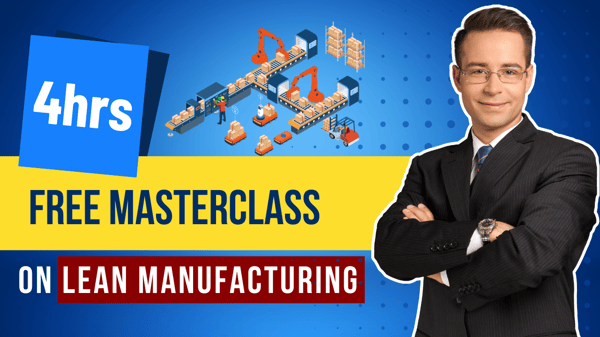Who we are?
At EALSS Academy, we are dedicated to empowering professionals and organizations through cutting-edge learning solutions in Lean Six Sigma, Operational Excellence, Leadership, Lean Manufacturing, and Data Analysis.
Our holistic programs go beyond theory, equipping learners with practical tools to drive real-world business transformations. (IASSC/ASQ BOK aligned)
Recognized as a globally respected provider of professional education, EALSS Academy Trainers are IASSC and CSSC Accredited Training Associate (ATA) offers courses that cover diverse fields, including Lean Six Sigma, Lean Manufacturing, ISO Standards, Operational Excellence, and Data Analysis.
Whether you’re a graduate, executive, quality/operations manager, or an aspiring project leader, our expert instructors bring over 25 years of industry experience to ensure meaningful learning outcomes.
We pride ourselves on being an MSME-registered company, committed to delivering value with integrity, quality, and social responsibility.
Through interactive live sessions, hands-on projects, and globally recognized certifications, EALSS Academy continues to shape the careers of thousands of professionals worldwide.

4.9 /5
Certified Lean Six Sigma with Minitab Training Program
& 3 Certification.
Six Sigma is a collection of quality management techniques and technologies.
It is a data-driven, systematic process improvement methodology
for eliminating flaws in any process.
Become a Globally Certified Lean Six Sigma Professional
Transform the way you work and accelerate your career with our Lean Six Sigma with Minitab Live Training Program. This hands-on, expert-led program is designed to equip professionals with the tools and knowledge to lead process improvements, reduce waste, and make data-driven decisions that deliver measurable business results.
This program offers a comprehensive learning experience through three globally recognized certifications—Yellow Belt, Green Belt, and Black Belt—all integrated with Minitab, the industry-standard statistical software.
Whether you’re a project manager, quality professional, or operations expert, you’ll master the art of improving processes and driving organizational excellence.
With interactive live sessions, real-world case studies, and hands-on projects, you won’t just learn theory—you’ll gain practical insights that you can apply immediately to your role.
Accredited Training Associate (ATA) by :

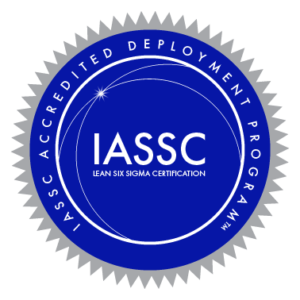
Let's talk
What Makes This Program Unique?
3 Globally Recognized Verified Lean Six Sigma Certifications with Lifetime Validity.
After completing the training program with the final exams, you will be awarded a Certified Lean Six Sigma Yellow Belt, Green Belt, and Black Belt Certification with a verified certification ID (with lifetime validity).
Highly Engaging 147 hrs of Training Content Approved by Experts.
147 hours of highly engaging and practical training content aligned with IASSC/ASQ Lean Six Sigma Black Belt Body of Knowledge. 42 hrs of Live session recordings + 13 hrs of Yellow belt content + 22 hrs of Green belt content + 40 hrs of Black Belt content + 35 to 40 hrs of live training sessions.
40 hrs of Live Training Sessions with IASSC/CSSC Accredited Trainer.
Along with recordings and content access, as a part of this training program, you can attend 40 hrs of live training sessions with Master Black Belt and IASSC/CSSC Accredited Trainer. Throughout the live training sessions you will learn Lean Six Sigma with Minitab Data Analysis up to Black Belt level.
Minitab Based Black Belt Level Training Program.
In this training program, you will learn Minitab data analysis software practically using real-time data up to the Black Belt level, which will improve your data analysis skills to lead improvement projects.
1 Year Access to Complete Lean Six Sigma with Minitab Training Content.
You will get 1 year of Lean Six Sigma with Minitab training content access. You can watch the complete training content throughout the 1 year for revision purposes.
Practical Learning with Doubt Solving.
During interactive live training sessions, you can interact with the Master Black Belt Trainer on different Lean Six Sigma and Minitab data analysis topics, discuss your doubts in every live session, and clear your doubts properly.
Training Program Curriculum
The accelerated Lean Six Sigma with Minitab training program helps you master Lean Six Sigma with Minitab Data Analysis in detail. Successful candidates will be awarded the Yellow Belt, Green Belt, & Black Belt Certification from EALSS Academy after passing the included certification exams.
1. Organization-wide Planning and Deployment
A. Organizational Goals
Strategic planning and alignment with Six Sigma
Business drivers and metrics
Financial measures (ROI, cost of poor quality, etc.)
B. Organizational Structure and Roles
Six Sigma roles and responsibilities (Champions, Belts)
Organizational communication
Change management strategies
C. Organizational Roadblocks
Identifying and overcoming resistance
Cultural challenges in deployment
2. Organizational Process Management and Measures
- A. Process Management Concepts
Value stream mapping (VSM)
Process elements and flow
Process analysis and redesign
- B. Performance Metrics
Key performance indicators (KPIs)
Leading vs. lagging indicators
Balanced scorecard approach
- C. Financial Measures
Cost of poor quality (COPQ)
Budgeting and project financials
Voice of the customer (VOC) to ROI linkage
3. Team Management
A. Team Formation and Group Dynamics
- Team stages (forming, storming, norming, performing)
- Team roles and responsibilities
B. Team Facilitation
Conflict resolution
Meeting management
Decision-making methods
C. Team Communication
Communication strategies and tools
Active listening
- Engagement and motivation
D. Team Leadership
Coaching and mentoring
Situational leadership
Managing virtual teams
4. Define Phase
1.1 The Basics of Six Sigma
1.1.1 Meanings of Six Sigma
1.1.2 General History of Six Sigma & Continuous Improvement
1.1.3 Deliverables of a Lean Six Sigma Project
1.1.4 The Problem Solving Strategy Y = f(x)
1.1.5 Voice of the Customer, Business and Employee
1.1.6 Six Sigma Roles & Responsibilities
1.2 The Fundamentals of Six Sigma
1.2.1 Defining a Process
1.2.2 Critical to Quality Characteristics (CTQ’s)
1.2.3 Cost of Poor Quality (COPQ)
1.2.4 Pareto Analysis (80:20 rule)
1.2.5 Basic Six Sigma Metrics
a. including DPU, DPMO, FTY, RTY Cycle Time; deriving these metrics
1.3 Selecting Lean Six Sigma Projects
1.3.1 Building a Business Case & Project Charter
1.3.2 Developing Project Metrics
1.3.3 Financial Evaluation & Benefits Capture
1.4 The Lean Enterprise
1.4.1 Understanding Lean
1.4.2 The History of Lean
1.4.3 Lean & Six Sigma
1.4.4 The Seven Elements of Waste
a. Overproduction, Correction, Inventory, Motion, Overprocessing, Conveyance, Waiting.
1.4.5 5S
a. Sort, Straighten, Shine, Standardize, Self-Discipline
5. Measure Phase
2.1 Process Definition
2.1.1 Cause & Effect / Fishbone Diagrams
2.1.2 Process Mapping, SIPOC, Value Stream Map
2.1.3 X-Y Diagram
2.1.4 Failure Modes & Effects Analysis (FMEA)
2.2 Six Sigma Statistics
2.2.1 Basic Statistics
2.2.2 Descriptive Statistics
2.2.3 Normal Distributions & Normality
2.2.4 Graphical Analysis
2.3 Measurement System Analysis
2.3.1 Precision & Accuracy
2.3.2 Bias, Linearity & Stability
2.3.3 Gage Repeatability & Reproducibility
2.3.4 Variable & Attribute MSA
2.4 Process Capability
2.4.1 Capability Analysis
2.4.2 Concept of Stability
2.4.3 Attribute & Discrete Capability
2.4.4 Monitoring Techniques
6. Analyze Phase
3.1 Patterns of Variation
3.1.1 Multi-Vari Analysis
3.1.2 Classes of Distributions
3.2 Inferential Statistics
3.2.1 Understanding Inference
3.2.2 Sampling Techniques & Uses
3.2.3 Central Limit Theorem
3.3 Hypothesis Testing
3.3.1 General Concepts & Goals of Hypothesis Testing
3.3.2 Significance; Practical vs. Statistical
3.3.3 Risk; Alpha & Beta
3.3.4 Types of Hypothesis Test
3.4 Hypothesis Testing with Normal Data
3.4.1 1 & 2 sample t-tests
3.4.2 1 sample variance
3.4.3 One Way ANOVA
a. Including Tests of Equal Variance, Normality Testing and Sample Size calculation, performing tests and interpreting results.
3.5 Hypothesis Testing with Non-Normal Data
3.5.1 Mann-Whitney
3.5.2 Kruskal-Wallis
3.5.3 Mood’s Median
3.5.4 Friedman
3.5.5 1 Sample Sign
3.5.6 1 Sample Wilcoxon
3.5.7 One and Two Sample Proportion
3.5.8 Chi-Squared (Contingency Tables)
a. Including Tests of Equal Variance, Normality Testing and Sample Size calculation, performing tests and interpreting results.
7. Improve Phase
4.1 Simple Linear Regression
4.1.1 Correlation
4.1.2 Regression Equations
4.1.3 Residuals Analysis
4.2 Multiple Regression Analysis
4.2.1 Non- Linear Regression
4.2.2 Multiple Linear Regression
4.2.3 Confidence & Prediction Intervals
4.2.4 Residuals Analysis
4.2.5 Data Transformation, Box Cox
4.3 Designed Experiments
4.3.1 Experiment Objectives
4.3.2 Experimental Methods
4.3.3 Experiment Design Considerations
4.4 Full Factorial Experiments
4.4.1 2k Full Factorial Designs
4.4.2 Linear & Quadratic Mathematical Models
4.4.3 Balanced & Orthogonal Designs
4.4.4 Fit, Diagnose Model and Center Points
4.5 Fractional Factorial Experiments
4.5.1 Designs
4.5.2 Confounding Effects
4.5.3 Experimental Resolution
8. Control Phase
5.1 Lean Controls
5.1.1 Control Methods for 5S
5.1.2 Kanban
5.1.3 Poka-Yoke (Mistake Proofing)
5.2 Statistical Process Control (SPC)
5.2.1 Data Collection for SPC
5.2.2 I-MR Chart
5.2.3 Xbar-R Chart
5.2.4 U Chart
5.2.5 P Chart
5.2.6 NP Chart
5.2.7 Xbar-S Chart
5.2.8 CuSum Chart
5.2.9 EWMA Chart
5.2.10 Control Methods
5.2.11 Control Chart Anatomy
5.2.12 Subgroups, Impact of Variation, Frequency of Sampling
5.2.13 Center Line & Control Limit Calculations
5.3 Six Sigma Control Plans
5.3.1 Cost Benefit Analysis
5.3.2 Elements of the Control Plan
5.3.3 Elements of the Response Plan
9. Design for Six Sigma (DFSS) Frameworks and Methodologies
A. DFSS Overview
When to use DFSS
Differences between DMAIC and DFSS
B. Common DFSS Methodologies
DMADV (Define, Measure, Analyze, Design, Verify)
IDOV (Identify, Design, Optimize, Verify)
C. Tools for DFSS
Quality Function Deployment (QFD)
Robust design, transfer function modeling
Book your Complimentary Career Mentoring Session
Discover your potential through complimentary career counseling sessions that empower your future!
Features of Program
- Expert live sessions: 40 hrs of live instructor-led training sessions covering DMAIC methodology with hands-on Minitab practice.
- Live session recordings access: 42 hrs of live session recordings for flexible learning and revision, allowing participants to revisit key concepts anytime.
- Yellow Belt Level Self Learning content: 13 hrs of Yellow Belt self-learning content aligned with IASSC/ASQ/CSSC Yellow Belt Body of Knowledge for in-depth understanding.
- Green Belt Level Self Learning content: 22 hrs of Green Belt self-learning content aligned with IASSC/ASQ/CSSC Green Belt Body of Knowledge for in-depth understanding.
- Black Belt Level Self Learning content: 40 hrs of Black Belt self-learning content aligned with IASSC/ASQ/CSSC Black Belt Body of Knowledge for in depth Understanding.
- Study Material & Templates: 12 real-life data-driven case studies, Lean Six Sigma study manuals, 5 reference books, and 47 ready-to-use quality tool templates.
- 3 Globally Recognized Certifications: Certified Lean Six Sigma Yellow Belt, Green Belt, and Black Belt upon successful completion of exams and training.
Benefits of Program
- Boost Career Growth: Lean Six Sigma certifications are globally recognized, making you stand out in the job market.
- In-Demand Skills Across Industries: Skills in Lean Six Sigma are sought after in manufacturing, healthcare, IT,finance, and more.
- Career Flexibility and Leadership: Qualify for roles in quality management, process improvement, or operational leadership.
- Drive Organizational Impact: Lead continuous improvement projects and help organizations reduce costs and enhance quality.
- Increase Process Efficiency: Learn to eliminate waste, reduce process variation, and improve workflows.
- Data-Driven Problem Solving: Gain expertise in using tools like Minitab for statistical analysis and decisionmaking.
- Higher Earning Potential: Professionals with Lean Six Sigma certifications often enjoy better salaries and promotions.
- Enhance Your Leadership Abilities: Lean Six Sigma training helps you lead process improvements, engage teams, and drive cultural transformation.
Key Skills You Learn
DMAIC Methodology Mastery
Minitab Data Analysis Mastery
Data Driven Problem Solving
Lean Six Sigma Tools Mastery
Process/Quality Improvement
Operational Excellence
Project Management
Quality Management
Who Can Join Our Program?
Process/Quality Engineers
Business Analysts
Quality Control Inspectors
Program/Project Managers
Quality Analysts and Managers
Manufacturing/healthcare/service professionals.
Anyone Seeking to Improve Processes
Process Improvement Consultant
Operational Excellence Leaders
Operations Manager/Directors

Demand for Certified Lean Six Sigma Practitioners
The Global professional services market is expected to reach USD 1.07 trillion by 2027, with a CAGR of 9.4% from 2024 to 2029.
20-25%
Expected Job Growth for Lean Six Sigma Practitioner profile by 2030
10-15%
Revenue growth for organisations improving process quality
$85K-$160K
Average annual salary for Certified Lean Six Sigma Professionals
Hiring Companies


Program Advisors

Santosh Govind Bhosale (MBB)

Ashwin More (BB)
Sample Certificates
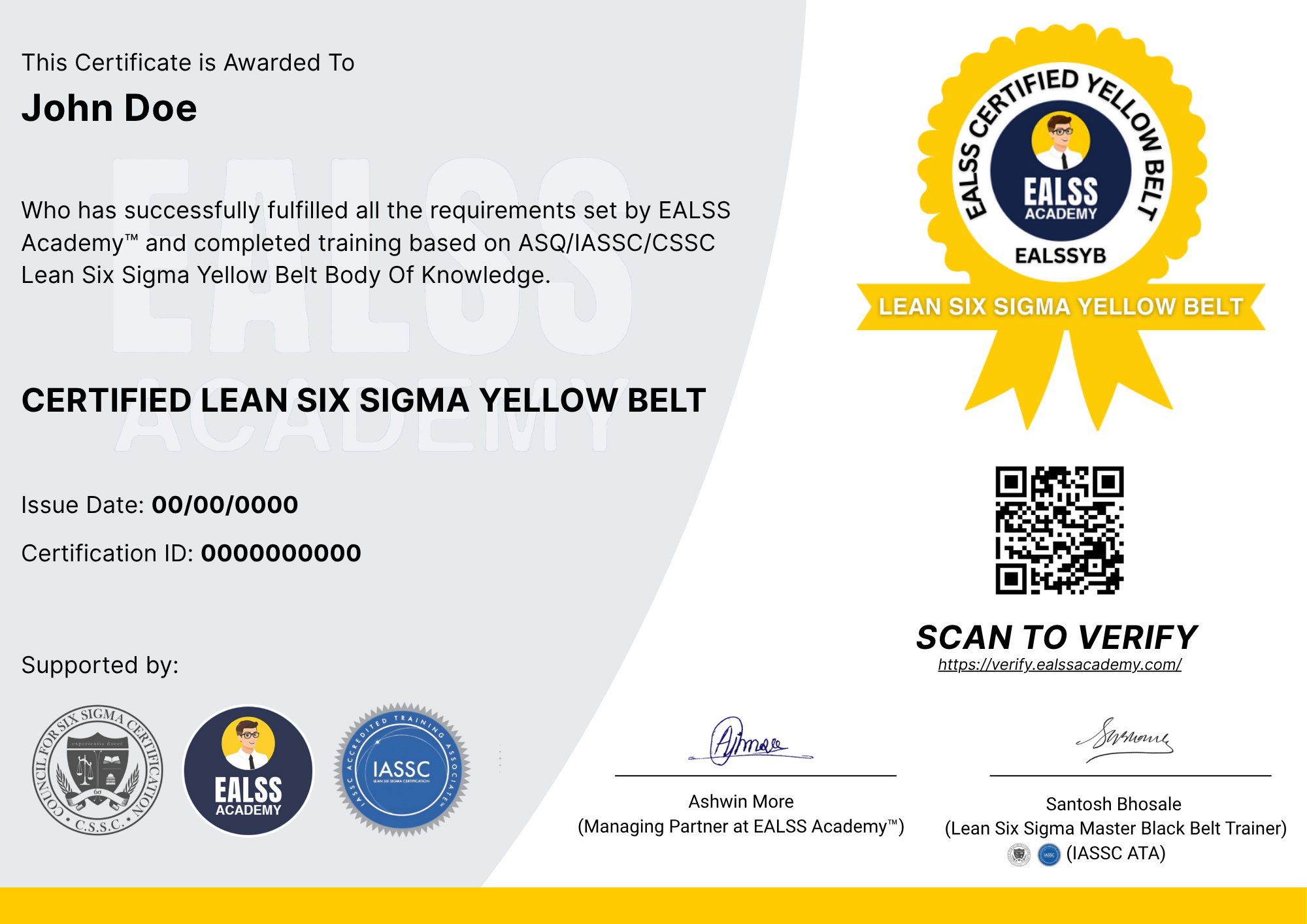
After this training program completion, you will get the Certified Lean Six Sigma Yellow Belt Certification with Lifetime Validity from EALSS Academy signed by a Master Black Belt and IASSC/CSSC Accredited trainer with a unique verified certification ID.
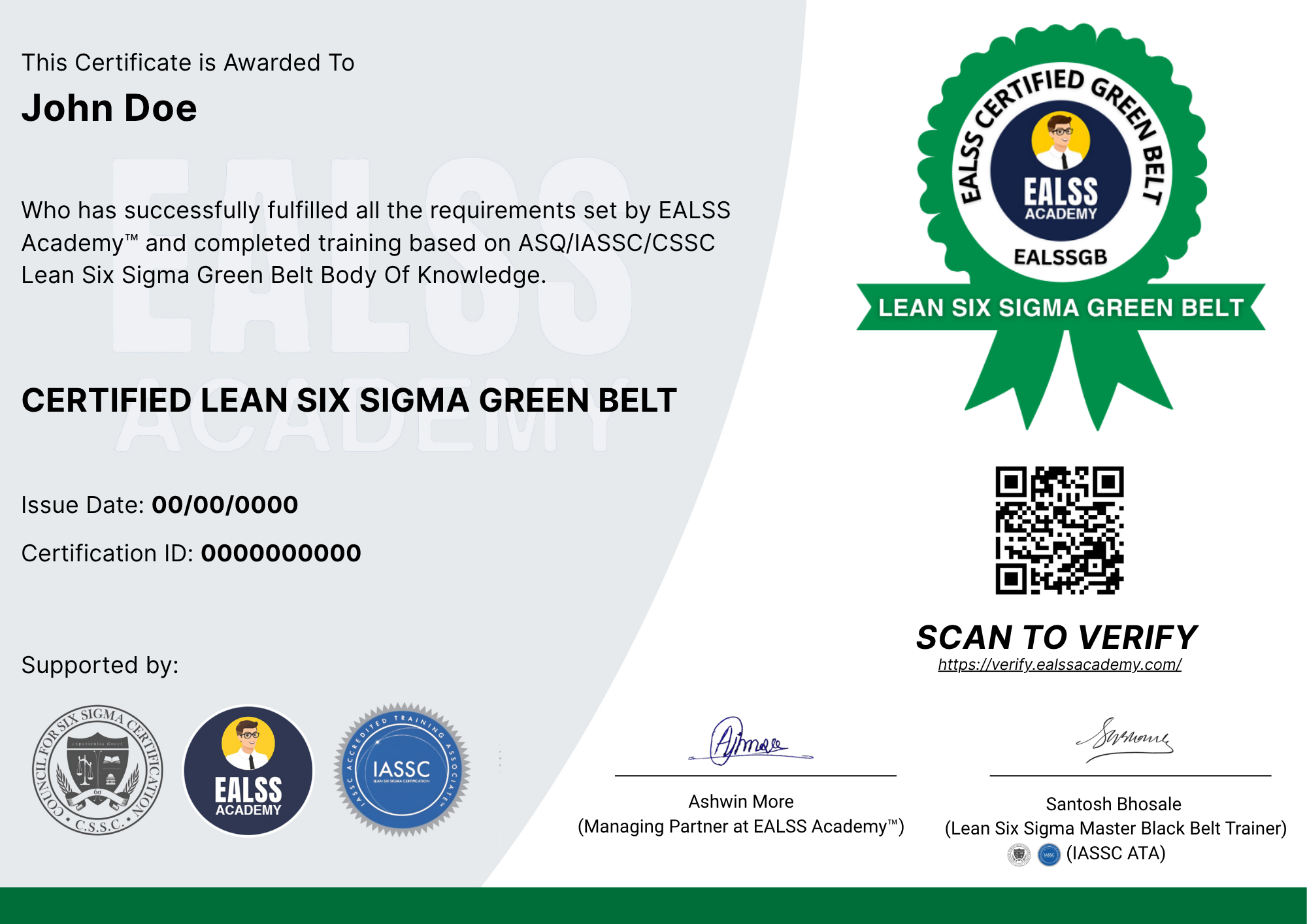
After this training program completion, you will get the Certified Lean Six Sigma Green Belt Certification with Lifetime Validity from EALSS Academy signed by a Master Black Belt and IASSC/CSSC Accredited trainer with a unique verified certification ID.
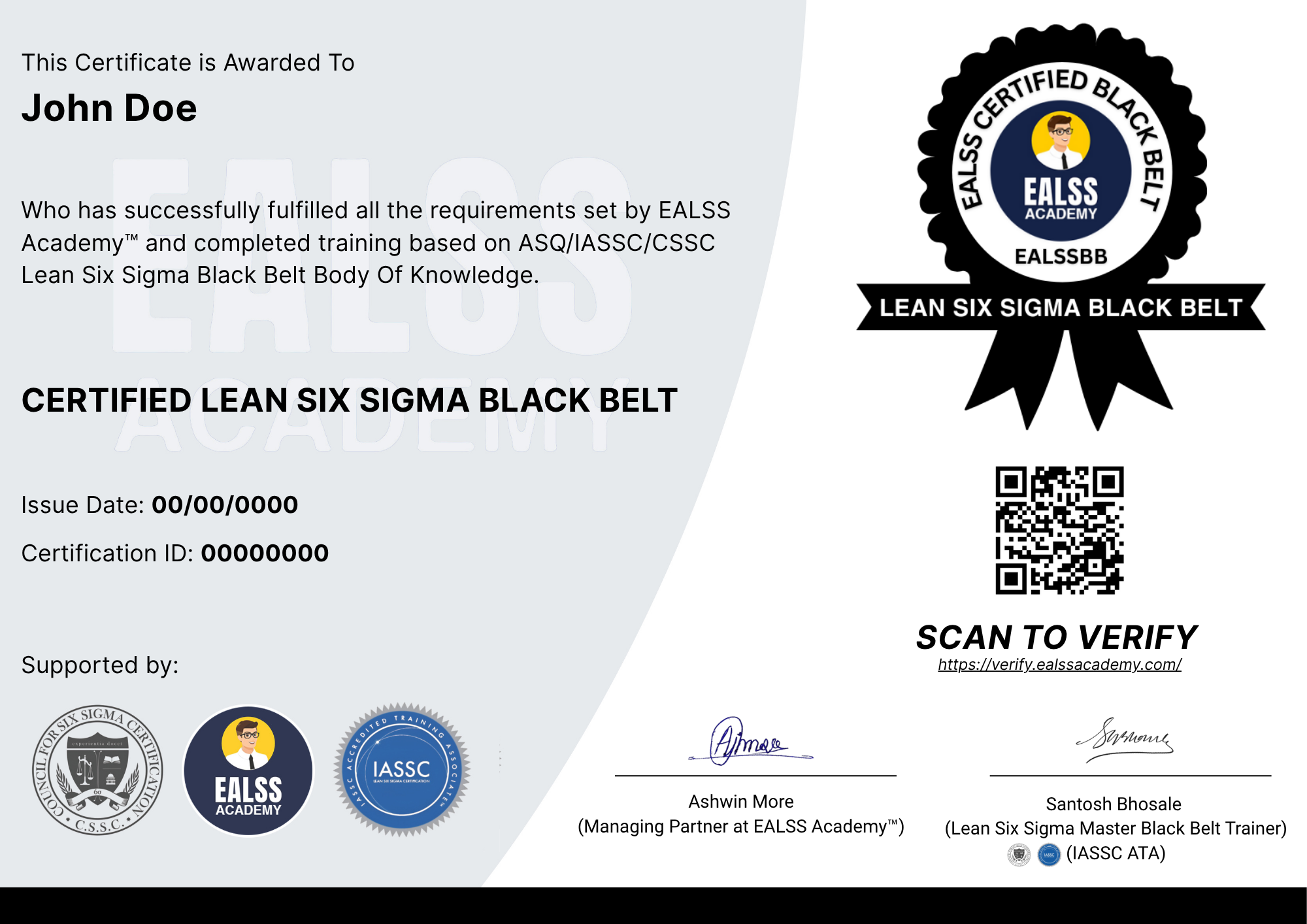
After this training program completion, you will get the Certified Lean Six Sigma Black Belt Certification with Lifetime Validity from EALSS Academy signed by a Master Black Belt and IASSC/CSSC Accredited trainer with a unique verified certification ID.
3 Enrollment Options
1. Self-Paced Recorded Training Program
Learn at your convenience with complete flexibility
- Full access to recorded training content (video lectures)
- Study material, exams, templates, and projects included
- Lifetime certification after successful exam completion
- Doubt-solving support via LMS chat system
- 1-year LMS access to content and recordings
Ideal for:
Independent learners
Professionals who prefer 100% flexible timing
Those confident in managing their own study pace
2. Self-Paced Recorded Training + 4 Expert Doubt-Solving Sessions
Flexibility + Expert Mentorship when you need it. (Including option 1 benefits)
- Full access to recorded training content (video lectures) with study materials.
- Lifetime certification after successful exam completion
- PLUS 4 personalized live doubt-solving sessions with an Expert Trainer (schedule as per your time)
- Solve doubts, discuss case studies, or clarify exam questions directly with a mentor
Ideal for:
Learners who prefer flexibility but need occasional expert guidance
Busy professionals who want to balance self-learning + mentorship
3. Complete Live Training Program with Expert Trainer
Structured live learning experience with community and mentorship
- All benefits of Option 1 & 2
- PLUS 9–10 live training sessions (typically held on Sundays) with Expert Trainer
- Real-time interaction, case studies, live discussions, and project guidance
- Access to live session recordings if you miss any class
Ideal for:
Learners who want a classroom-like experience
Those who prefer live interaction, motivation, and structured progression
Professionals aiming to complete training in a defined timeframe
Client Testimonials

Zainoirwan Bin Zainuddin
EALSS Academy certainly offers a very good platform for working professionals like me to pursue professional certification online. I’m in the middle of completing the (GB + BB) Live training program and I feel it has the best learning material plus a highly experienced Master Black Belt Coach who relentlessly coaches all his students to master each topic of DMAIC methodology.
Zainoirwan Bin Zainuddin

Sriram Nagarajan
Santosh sir delivered in depth Lean Six Sigma Black Belt training with practical Minitab analysis examples including Design Of Experiments (DOE). Extremely value adding course for anyone from beginners to expert practitioners as Santosh sir used real life business case studies to solidify understanding of advanced concepts. Thank you
Sriram Nagarajan

Siddanna Ramanakatti
Lean Six Sigma with Minitab training was superb, as we are very lucky to have a Master Black belt trainer, he has good knowledge of problem-solving tools and before joining the training I had zero knowledge of Minitab but now I’m able to analyze data through the Minitab software as well as interpret it easily. These 4 weeks of live sessions were very interactive along with support from EALSS Academy.
Siddanna Ramanakatti
Frequently Asked Questions
1. What is Lean Six Sigma and why should I learn it?
Lean Six Sigma is a globally recognized methodology used to improve business processes by eliminating waste, reducing variation, and solving complex problems. It’s highly valued in industries like manufacturing, IT, healthcare, and services — and is a must-have skill for professionals in quality, operations, and project management roles.
2. Do I need any prior experience to enroll?
No prior experience is required. The program is designed to take you from beginner (Yellow Belt) to intermediate (Green Belt) and finally to advanced (Black Belt) level. We explain every tool and concept from scratch — step-by-step.
3. What is Minitab and why is it included?
Minitab is one of the most powerful software tools used in Six Sigma for data analysis. You’ll learn to apply tools like Control Charts, Pareto Charts, Histograms, Hypothesis Testing, and more — all using Minitab. This boosts your resume and practical capability.
4. Will I get certified after completing the program?
Yes. You will earn three separate certifications:
– Lean Six Sigma Yellow Belt
– Lean Six Sigma Green Belt
– Lean Six Sigma Black Belt
Each certification is issued upon passing the respective exam and completing training requirements
5. How are the exams conducted?
All exams are conducted online and are open-book, scenario-based assessments. You can
take the exams from anywhere, and multiple attempts are allowed
6. What if I miss a live session?
No worries. All live sessions are recorded and uploaded to the LMS portal, where you will have 1-year access to watch and revise anytime.
7. How long does it take to complete all 3 certifications?
The full program spans approximately: if you enroll for self paced option, You can complete it at your own pace, or follow our weekend live training batches over 2 to 3 months.
8. Will I get project experience or case studies?
Yes. The training includes real business case studies and Minitab datasets so you can practice tools like DMAIC, Root Cause Analysis, and Process Capability Analysis.
9. Will this certification help me in getting a job or promotion?
Yes. Lean Six Sigma certifications are highly respected by employers worldwide. Professionals with these certifications often stand out in roles related to Quality, Operations, Project Management, Business Analysis, and more.
10. Is the certificate globally recognized?
Yes. The training is aligned with ASQ and IASSC standards, and the certificates carry the “Certified” tag issued by EALSS Academy, which is recognized across industries
11. What support will I receive during the training?
You’ll get access to:
– Expert trainer during live sessions
– WhatsApp/Email support
– LMS chat for doubt solving
– Post-training career guidance
12. Can I pay in installments or enroll as per my budget?
You can also choose between 3 enrollment options that match your learning style and budget: self-paced, self-paced paced+ 4 doubt-solving, or complete live training packages based on your budget.
Other Recomended Cources
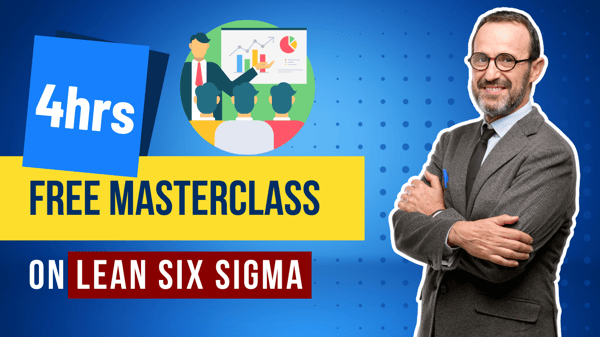
Lean Six Sigma fundamentals
4hrs Masterclass on Lean Six Sigma fundamentals to understand the basics of this powerful problem-solving methodology

